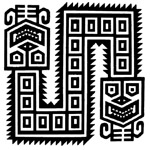Center, Textile Research

PreColumbian Textile Conference VII / Jornadas de Textiles PreColombinos VII (2016)
Date of this Version
11-13-2017
Document Type
Article
Citation
In PreColumbian Textile Conference VII / Jornadas de Textiles PreColombinos VII, ed. Lena Bjerregaard and Ann Peters (Lincoln, NE: Zea Books, 2017), pp. 259–276
doi:10.13014/K22N50FZ
Abstract
A wooden statuette clad in small-scale garments made from a Wari style tie-dyed textile joined the collections of the City of Liverpool Public Museum (now National Museums Liverpool) in 1951 along with other items distributed by the trustees of the Wellcome Historical Medical Museum. This article discusses Wari style tie-dyed tunics as part of an ensemble of garments. It explores the character of the Wari period textile (c. AD 600-1000) used for dressing the statuette, its similarity to textiles in the Fowler Museum at the University of California, Los Angeles and the Museo Nacional de Arqueología, Antropología e Historia del Perú, as well as the chronological mismatch between the style of the textile and that of the wooden figurine. Unless the statuette was made to order in recent times to be dressed in an ancient textile, it is perhaps Late Horizon (c. 1430 - 1532) in date. Sir Henry Wellcome acquired the statuette before his death in 1936, at a time when there was an emergent market in unprovenanced pre-Hispanic antiquities. The statuette is a composite figurine clad in bespoke garments made from an older textile. Its appearance bears witness to collecting practices which included modifying ancient artefacts to appeal to modern collectors and it destabilises simple understandings of what the dressed aspect of the statuette can convey to a museum visitor.
El curioso caso de la estatuilla de madera de Sir Henry Wellcome, vestida con paño Wari
Resumen -- Una figurilla de madera vestida en prendas a escala reducida, fabricadas con un textil con teñido por amarre de estilo Wari se sumió a las colecciones del Museo Público de la Ciudad de Liverpool (actualmente Museos Nacionales Liverpool) en 1951, junto a otros objetos distribuidos por los fiduciarios del Museo Médico Histórico Wellcome. Este artículo considera las túnicas de estilo Wari teñidos por amarre como parte de un conjunto de indumentaria. Se explora el carácter del textil del período Wari (c. AD 600-1000) utilizada para vestir la figurilla, su similitud a los textiles en el Museo Fowler de la Universidad de California Los Angeles y el Museo Nacional de Arqueología, Antropología e Historia del Perú, tanto como el desencuentro cronológico entre el estilo del textil y el de la figurilla de madera. Excepto que la figurilla haya sido fabricada a la medida en tiempos recientes para ser vestida en un textil antiguo, data posiblemente al Horizonte Tardío (c. 1430 - 1532). Sir Henry Wellcome adquirió la figurilla antes de su fallecimiento en 1936, en una época cuando había un mercado emergente de antigüedades pre-hispánicas sin procedencia. Se trata de una figurilla compuesta, vestida en prendas hecha a la medida de un textil más antiguo. Su apariencia es testigo a prácticas de coleccionar, las que incluyen modificar los artefactos antiguos para que sean más atractivos a los coleccionistas modernos y
Included in
Art and Materials Conservation Commons, Chicana/o Studies Commons, Fiber, Textile, and Weaving Arts Commons, Indigenous Studies Commons, Latina/o Studies Commons, Museum Studies Commons, Other History of Art, Architecture, and Archaeology Commons, Other Languages, Societies, and Cultures Commons


Comments
Copyright © 2017 by the author.